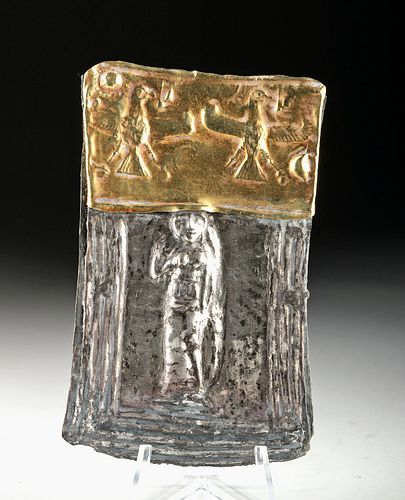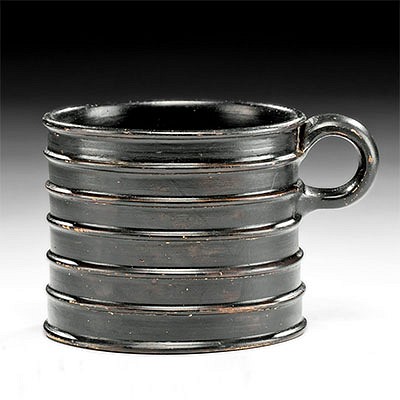Romano-Egyptian Gold / Silver Votive Panel - Horus
Lot 15b
About Seller
Artemis Gallery
686 S Taylor Ave, Ste 106
Louisville, CO 80027
United States
Selling antiquities, ancient and ethnographic art online since 1993, Artemis Gallery specializes in Classical Antiquities (Egyptian, Greek, Roman, Near Eastern), Asian, Pre-Columbian, African / Tribal / Oceanographic art. Our extensive inventory includes pottery, stone, metal, wood, glass and textil...Read more
Categories
Estimate:
$4,500 - $6,750
Absentee vs Live bid
Two ways to bid:
- Leave a max absentee bid and the platform will bid on your behalf up to your maximum bid during the live auction.
- Bid live during the auction and your bids will be submitted real-time to the auctioneer.
Bid Increments
| Price | Bid Increment |
|---|---|
| $0 | $25 |
| $300 | $50 |
| $1,000 | $100 |
| $2,000 | $250 |
| $5,000 | $500 |
| $10,000 | $1,000 |
| $20,000 | $2,500 |
| $50,000 | $5,000 |
| $100,000 | $10,000 |
| $200,000 | $20,000 |
About Auction
By Artemis Gallery
Mar 12, 2020
Set Reminder
2020-03-12 10:00:00
2020-03-12 10:00:00
America/New_York
Bidsquare
Bidsquare : Ancient / Ethnographic Around The World
https://www.bidsquare.com/auctions/artemis-gallery/ancient-ethnographic-around-the-world-4957
Ancient art from Egypt, Greece, Italy and the Near East, as well as Asian, Fossils, Pre-Columbian, Native American, African / Tribal / Oceanic, Spanish Colonial, Russian Icons, Fine art, much more! Artemis Gallery info@artemisgallery.com
Ancient art from Egypt, Greece, Italy and the Near East, as well as Asian, Fossils, Pre-Columbian, Native American, African / Tribal / Oceanic, Spanish Colonial, Russian Icons, Fine art, much more! Artemis Gallery info@artemisgallery.com
- Lot Description
Egypt, Romano-Egyptian period, ca. 1st to 2nd century CE. A beautiful votive plaque comprised of an upper gold register (75% gold, equivalent to 18K) with two images of the falcon god Horus in repousse and a nearly pure silver panel (98% silver) below presenting Isis. Horus, the tutelary deity, was oftentimes depicted as a falcon-headed man donning a pschent symbolizing his reign over the entire kingdom of Upper and Lower Egypt; however, he was also represented as a falcon. Isis, the Egyptian goddess of motherhood and fertility, stands and faces the viewer, raising her right hand to direct us to the Horus panel, while her left hand holds a palm frond by her side, and is surrounded by a striated border. The gold and silver panels are mounted to a bronze panel. Custom museum-quality display stand included Size: 2.375" W x 4" H (6 cm x 10.2 cm); total weight: 80.2 grams; precious metal quality: 75% gold, 98% silver
The ancient Egyptians believed that their pharaoh was a personification of Horus the sky god - depicted as either a falcon-headed man donning the pschent (a red and white crown) to symbolize his reign over Egypt or as the bird itself - a powerful icon of power, speed, and talent for hunting - as we see in this example. Isis was daughter to Geb, god of the Earth, and Nut, goddess of the Sky, and wife of Osiris. Oftentimes shown as the mother of Horus, she is also known as a protector of children. In addition to being revered as the ideal mother and wife, Isis was revered as the patroness of magic and nature, a supporter of sinners, slaves, and artisans as well as a friend to rulers and the wealthy.
Provenance: private East Coast, USA collection; ex-Frances Artuner collection, Belgium, acquired in the 1960s
All items legal to buy/sell under U.S. Statute covering cultural patrimony Code 2600, CHAPTER 14, and are guaranteed to be as described or your money back.
A Certificate of Authenticity will accompany all winning bids.
We ship worldwide and handle all shipping in-house for your convenience.
#146050Gold panel shows expected indentations and minute losses at the peripheries, but the imagery is still vivid. Silver panel shows surface wear, deposits, and losses to peripheries. The bronze panel on the back shows expected age wear with losses to a few fasteners, but nice remains of several, as well as a rich green patina.Condition
- Shipping Info
-
All shipping is handled in-house for your convenience. Your invoice from Artemis Gallery will include shipping calculation instructions. If in doubt, please inquire BEFORE bidding for estimated shipping costs for individual items.
-
- Buyer's Premium



 EUR
EUR CAD
CAD AUD
AUD GBP
GBP MXN
MXN HKD
HKD CNY
CNY MYR
MYR SEK
SEK SGD
SGD CHF
CHF THB
THB













